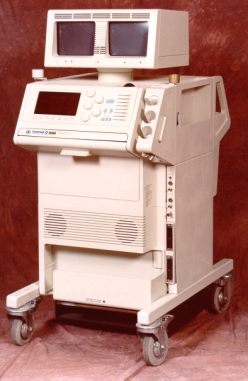
An ultrasound transducer generates acoustic waves by converting magnetic, thermal, and electrical energy into mechanical energy. The most efficient technique for medical ultrasound uses the piezoelectric effect, which was first demonstrated in 1880 by Jacques and Pierre Curie [Curie and Curie, 1880]. They applied a stress to a quartz crystal and detected an electrical potential across opposite faces of the material. The Curies also discovered the inverse piezoelectric effect by applying an electric field across the crystal to induce a mechanical deformation. In this manner, a piezoelectric transducer converts an oscillating electric signal into an acoustic wave, and vice versa. Many significant advances in ultrasound imaging have resulted from innovation in transducer technology. One such instance was the development of linear-array transducers. Previously, ultrasound systems had made an image by manually moving the transducer across the region of interest. Even the faster scanners had required several seconds to generate an ultrasound image, and as a result, only static targets could be scanned. On the other hand, if the acoustic beam could be scanned rapidly, clinicians could visualize moving targets such as a beating heart. In addition, real-time imaging would provide instantaneous feedback to the clinician of the transducer position and system settings. To implement real-time imaging, researchers developed new types of transducers that rapidly steer the acoustic beam. Piston-shaped transducers were designed to wobble or rotate about a fixed axis to mechanically steer the beam through a sector-shaped region. Linear sequential arrays were designed to
electronically focus the beam in a rectangular image region. Linear phased-array transducers were designed to electronically steer and focus the beam at high speed in a sector image format.
Equipment: ULTRAMARK 9 COLOR DOPPLER ULTRASOUND SYSTEM

Videos: 3D ultrasound heart, video1, video2, video3.
Download:
2-Applications in MEMS surgery